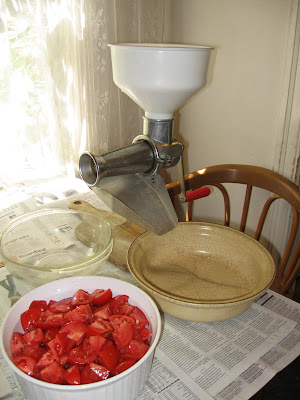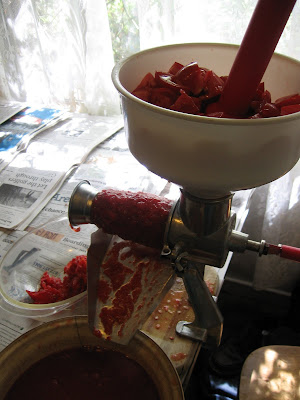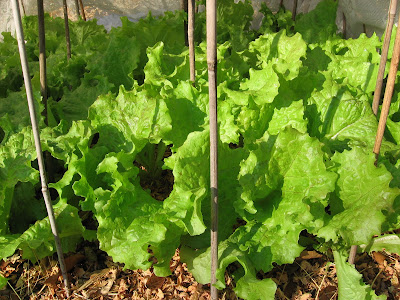
Another Monday has come and gone! Lots more portraits of gorgeous produce have been posted at
Daphne's Dandelions. It's thrilling to see the lush harvests people around the country are bringing in.
To add to the collective cornucopia, here is a belated record of what has come out of our backyard in the past two weeks.
Week of Monday August 17 through Sunday, August 23Tuesday, August 18Above, left to right: Lots of lovely, rustly, fragrant Genovese basil for pesto; Kentucky Wonder pole beans; Sungold cherry tomatoes; Blue Lake pole beans; Better Boy tomatoes; the last of the Tavera French haricot bush beans; Green Racer zucchini.
 Friday, August 21
Friday, August 21Kentucky Wonder pole beans; Better Boy tomatoes, including a couple of green ones that fell off the plant (they have ripened on the dining room table); Sungold cherry tomatoes; Cochella zucchini; lemon cucumbers; Green Racer zucchini; Blue Lake pole beans.
 Saturday, August 22
Saturday, August 22Red Sails summer lettuce; Sungold cherry tomatoes; Better Boy tomatoes. With the abundance of lettuce, cucumbers, and cherry tomatoes, we are gobbling up garden salads every night.
 Sunday, August 23
Sunday, August 23A Black Krim tomato! -- only the second one so far, but worth the wait; lemon cucumbers; Kentucky Wonder pole beans; Better Boy tomatoes; Blue Lake pole beans, Green Racer zucchini.
 Sunday, August 23
Sunday, August 23Trombetta di Albenga Italian squash. The biggest ones are about three feet long and almost ten pounds in weight. B. suggested we honor his Irish heritage by making
Shillelagh soup -- and indeed they do look like big cudgels. Ha ha.
Unfortunately, all but one of them started rotting from the bottom and ended up as biomass in the compost bin. The green, curvey, bulbous one in the middle has a hardened rind so I put it in the garage to see if it will last. I believe this variety can work as both a summer and a winter type. Meanwhile, there are several more growing. We will have another chance to actually cook one of them.
 Week of Monday, August 24 through Sunday, August 30Monday, August 24
Week of Monday, August 24 through Sunday, August 30Monday, August 24The last of the pears. We never did get hold of a ladder, but, with B.'s help, I stood on a kitchen stool and managed to pick most of what remained in the upper branches of the little pear tree. What I couldn't reach we shook down into the ivy below. About a third of those were lost to nicking and bruising but we still ended up with plenty to set ripening in the garage, with a few set aside in the refrigerator.
When ripe they are absolutely delicious. For all these years we have been letting gourmet fruit rot away untended. Sometimes we regret this, but when sweet pear juice is dripping down your chin, you just want to live in the moment.
 Wednesday, August 26
Wednesday, August 26Kentucky Wonder pole beans; Better Boy tomatoes; Sungold cherry tomatoes; lemon cucumbers; Blue Lake pole beans; Green Racer zucchini.
 Sunday, August 29
Sunday, August 29The biggest one-day harvest so far. Left to right: one overgrown Cochella zucchini; Red Sails lettuce; Genovese basil; Kentucky Wonder pole beans; nestled among the beans is one red cherry tomato from the volunteer plant growing amidst the morning glory vines; lemon cucumbers; Better Boy tomatoes; Blue Lake pole beans; Sungold cherry tomatoes; Green Racer zucchini. This represents pretty much all the vegetables in the garden except the Trombetta squash, oh, and also the peppers and eggplant which are not yet really up to speed.
It's really remarkable how productive an ordinary yard can be. I read a blog post recently that claimed there are
19 million acres of arable land in suburban yards across the county. And that's just the suburbs.
We are in a small city. I've noticed that more than a few people in our neighborhood have taken out their front lawns and replaced them with vegetable gardens. Who knows what is going on in the backyards.
Let the gardening revolution begin! Gardeners of the world, unite! You have nothing to lose but your counter space.
UPDATE:
Another source states there are 30 million acres of prime farmland in the suburbs now being tended as lawns. Key quote:
Fortunately, in the United States, “suburbia occupies vast swaths of former prime U.S. farmland. NASA’s ecological forecasting research group reports that the people living there already water about 30 million acres of lawn, three times the land planted in irrigated corn.
UPDATE 2: I found the original source for that quote.



















































